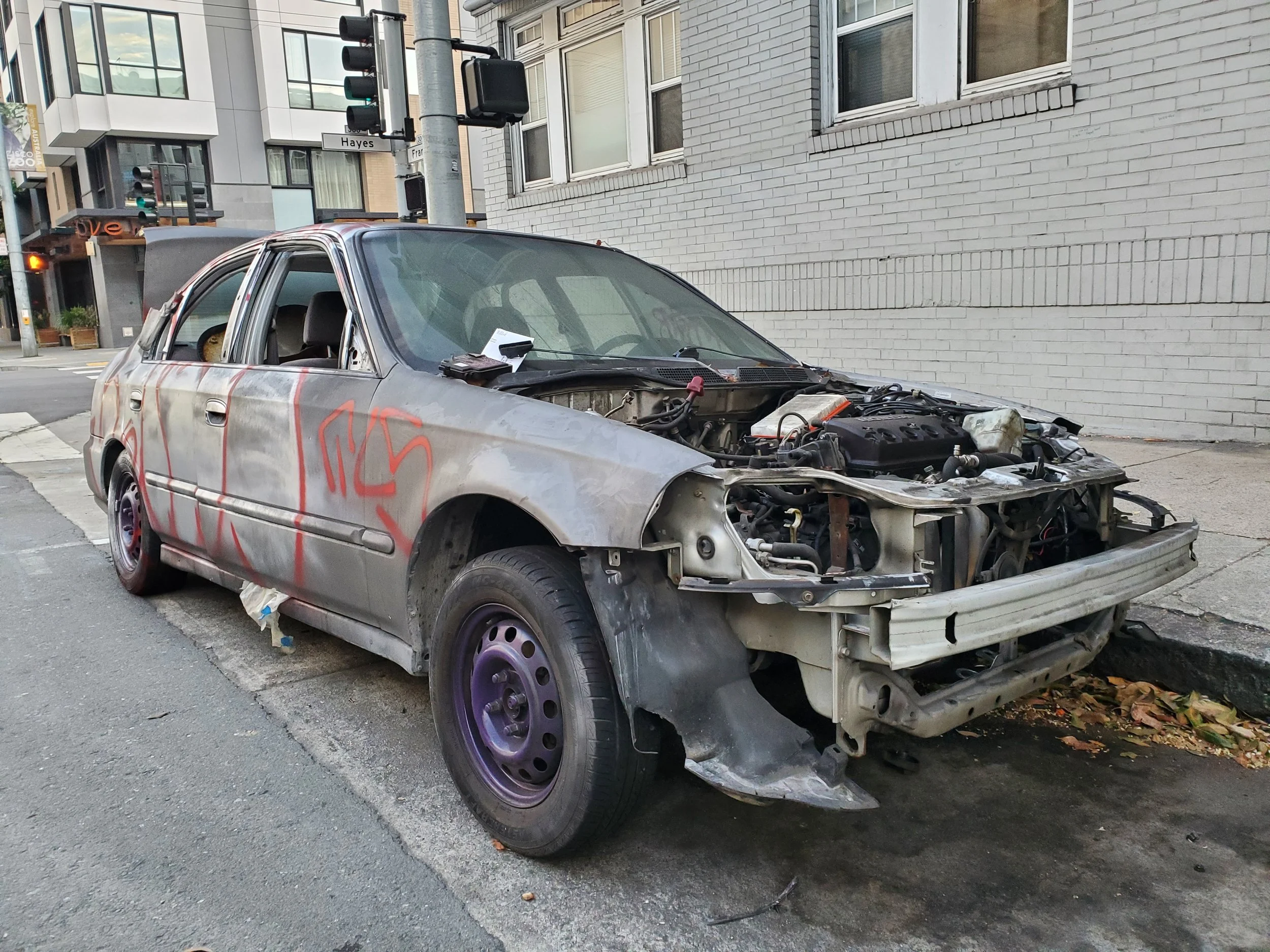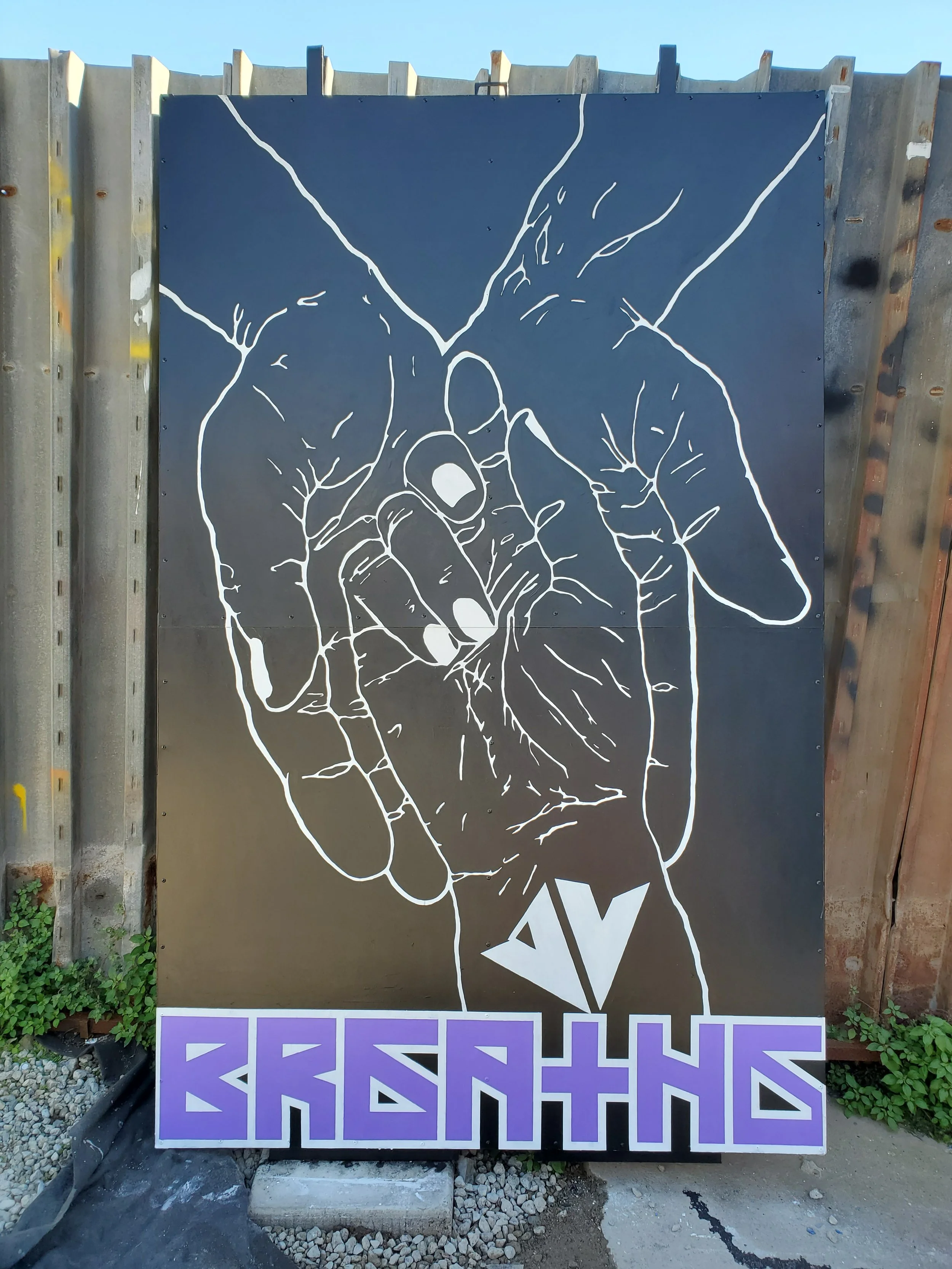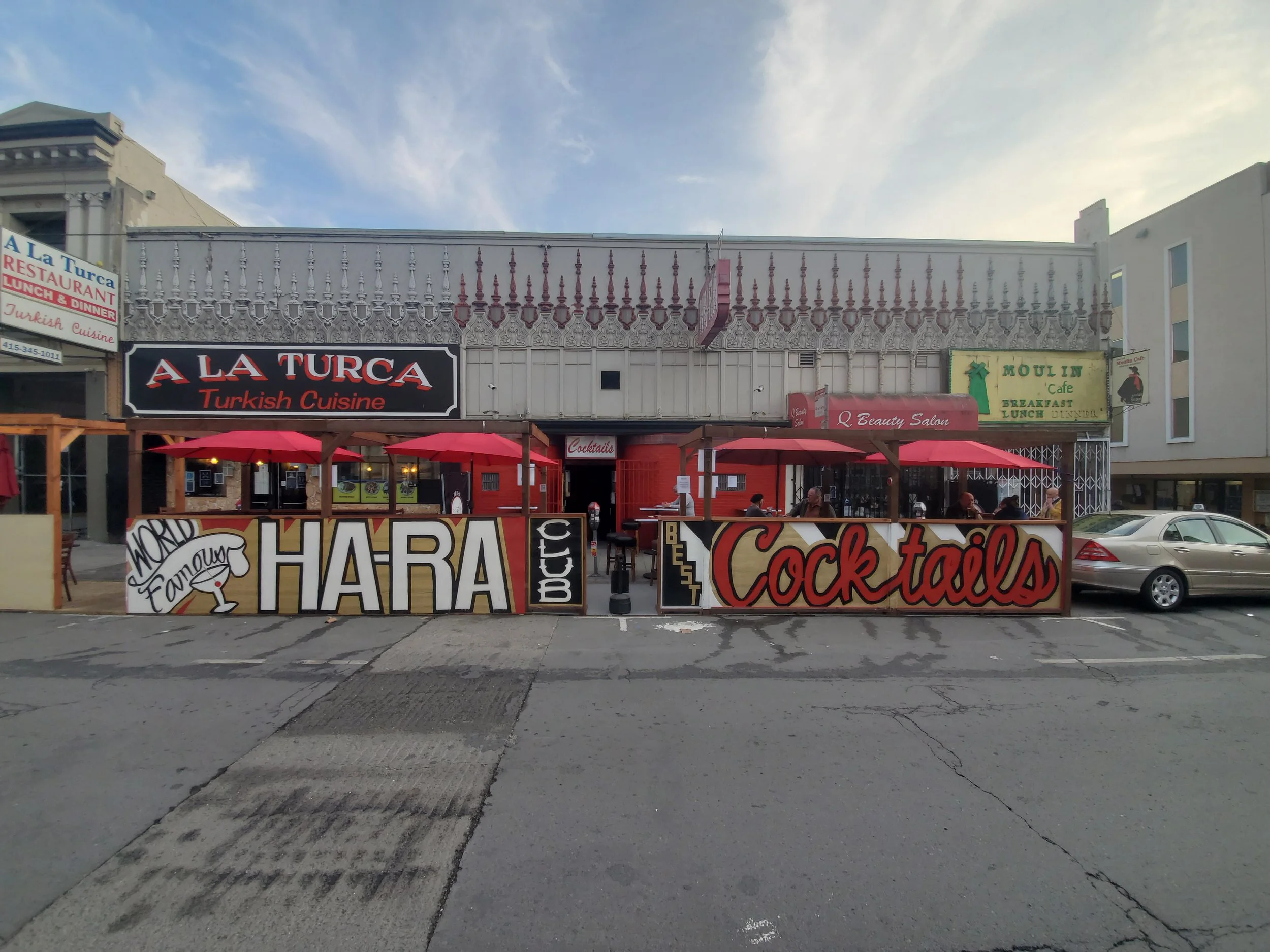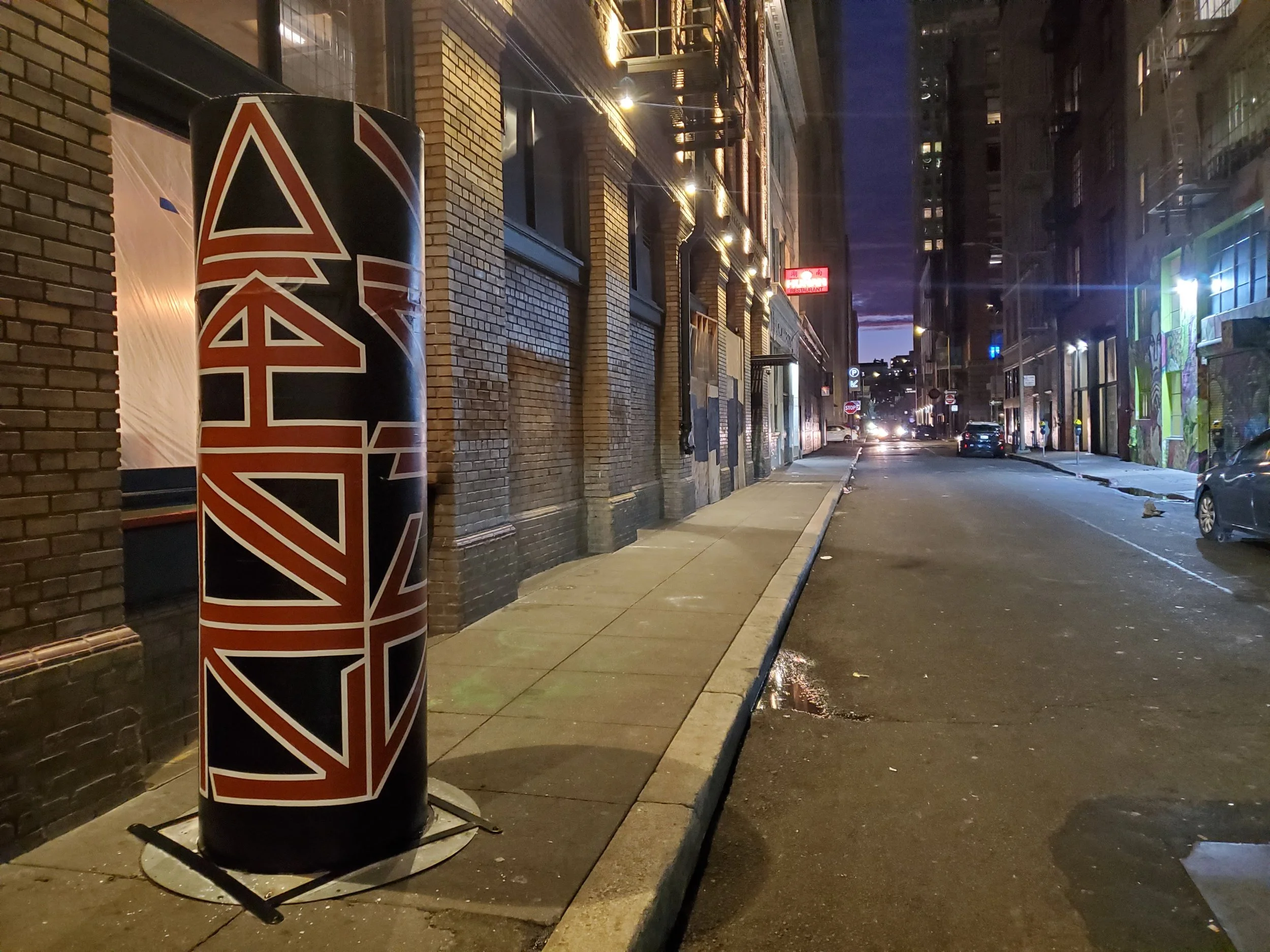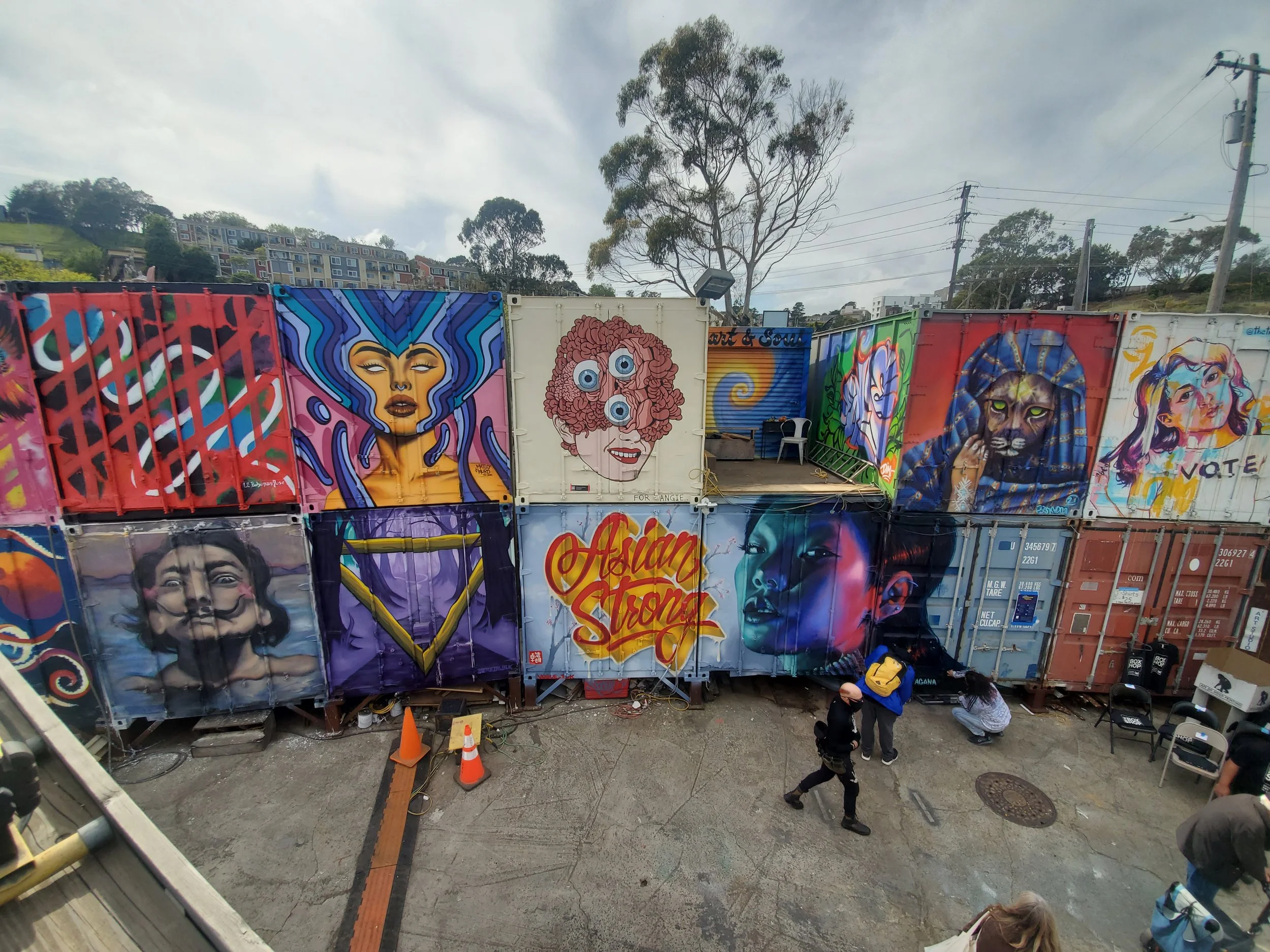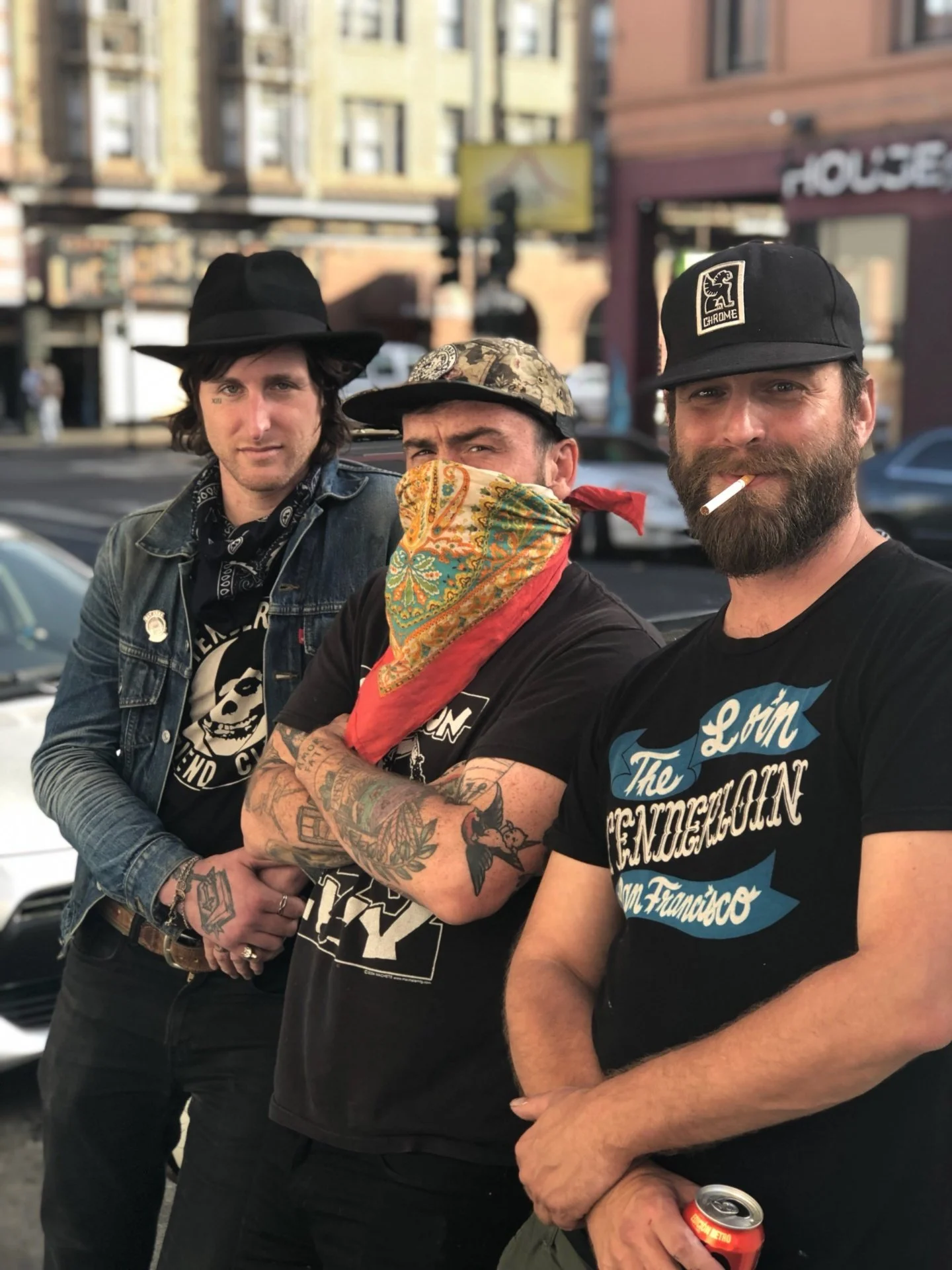The Great San Francisco Earthquake of 2020
By D Young V
D Young V mural on boarded up plywood outside of 910 and 912 Larkin (which would later become Moth Belly Gallery).
To better understand the San Francisco 2020 experience it’s best to look back a few years prior into this city's history to paint a fuller picture of this reality…
The term ‘earthquake’ is something anybody in San Francisco is more than familiar with. The great quake of 1906 nearly demolished San Francisco after the ensuing violent fires that occurred throughout the city as a result of the Earth shaking so violently. The 1989 Loma Prieta earthquake shook the Bay Area causing intensive destruction from here to Santa Cruz County, killing 63 people and causing billions of dollars in property damage. Being so close to the San Andreas Fault has given San Franciscans a fear of earthquakes that’s always resting somewhere in the backs of their minds.
D Young V drawing at Amsterdam Cafe. Summer of 2020.
Despite this city’s history of ground shaking devastation, it wasn’t until around 2012 when the word ‘earthquake’ would come up in conversation so often that it seemed to be a standard word in most daily communication. From this time forward I would hear this word continually for the next eight years. The only difference now was that this word was not spoken out of fear, but rather hope. For the people of San Francisco, the prospect of an earthquake appeared to become an act of nature that was no longer something to be threatened by, but instead welcomed with open arms.
It was around 2012 that the face of this city began to change at such an accelerated pace that very few people could comprehend and keep up with it. San Francisco had opened its doors to the tech wave and along with that came luxury residential/lifestyle development. This wave completely excluded its current residents. This is what city officials, property owners and building developers were labeling as ‘progress.’ In truth, what the vast majority of San Francisco residents at the time saw as this ‘progress’ was unregulated growth and severely unchecked capitalism.
What soon followed was a surge in violent crime, a wave of evictions across the city, an exodus of small businesses that were considered staples of their communities, thousands upon thousands of creative people that were forced to relocate in order seek opportunity in other cities, shut downs of creative spaces/galleries across the board and a general wave of animosity and distrust in the city many people had called home. What was once enthusiasm, inspiration, pride and hope amongst a population of people flourishing in a progressive city soon gave way to hate, despair, depression and confusion.
The first year of these changes saw rents across the city doubling, thus cutting off any possibility of new creative blood migrating to SF. In the years that followed the cost of rent became even more outrageous, surpassing even New York City as the most expensive American city to live in (without providing most of the opportunities and infrastructure that a city like NYC or many other US cities have). As the rent increased, small businesses gave way to overvalued ‘startups’, local dive bars became specialized ‘artisan’ cocktail lounges or craft brewery bars (all utilizing the same reclaimed wood aesthetic), art galleries became design firms, affordable studio apartments became ‘junior one bedrooms’ (studio apartment with a new wall running through the middle of it costing twice the price), the sidewalks once used for pedestrian walking became littered with countless abandoned scooters, the open minded and polite people you’d generally meet at social functions became aggressive, entitled, uncultured and rude clones of one another with no sense of themselves or regard for anyone around them, and what were once beautiful and safe streets to explore became home to endless homeless tent encampments.
By 2015 the entire city of San Francisco (and greater Bay Area) became a horrible version of a neglected society or the type of dystopian urban future popularized by science fiction literature and movies. The streets and alleyways were lined with tens of thousands of dilapidated tents, open air drug use was everywhere, some streets became so littered with needles you wouldn’t dare walk down them; all the while billions and billions of dollars were coming into the city and not a single drop of it trickling down. The landscape of the city had seemed to change overnight with massive ground level homelessness coupled with an entirely new city skyline displaying dozens upon dozens of brand new glistening high rise office buildings and condos. It was ironic (to say the least) to see floods of homeless people camping outside many of these new high rise residential buildings with open air drug dealing going down just a few feet away from their front doors. I think the full effect of it hit me when I found myself walking through what many would consider an affluent San Francisco neighborhood filled with multimillion dollar homes only to find people not only camped out but openly smoking meth and crack just a few feet away from the front steps of these homes.
D Young V mural at The Box Shop in Hunter’s Point.
It was around this point that I’d had enough of this city. SF was no longer a place somebody like me could flourish nor make a comfortable living in. Only few people can find peace of mind when their small studio apartment runs them $2,000 and up per month, complete with an inefficient property management company that wants them out after their first year lease is up so the company can charge even more money for rent after they leave, while providing great amenities like heroin needles at your front steps, trash throughout your hallway and endless mold issues. Sounds crazy? It’s not, this became the SF property management standard at the time. Property management companies would often go out of their way to make their tenant’s living situations so uncomfortable (through both incompetence and intent) that they’d often be forced to move. Tactics like these are often implemented by these companies in order to circumvent the tenant benefits of rent control.
Then 2020 hit…
The Covid pandemic provided a vast array of experiences throughout the world for all types of people, animals and environments. Some of these experiences can be seen as very negative and others highly positive. Such is life I suppose.
For a city like San Francisco, the general consensus is that the positive effects of the Covid pandemic far outweighed the negative. As soon as I received the news of Mayor London Breed’s city wide state of emergency regarding Covid on February 25th, 2020 I felt a sense of uncertainty that was soon overshadowed by an overwhelming feeling of enthusiasm. Would this new ‘Covid pandemic’ be the ‘earthquake’ that so many San Franciscans had been praying for throughout the last several years? Will something new and positive finally occur in this once great city that fell to the wayside of greed and corruption? Like so many others, I saw this new virus as a potential symbol of change and renewal. I thought of the forest fires that occur with the purpose of making way for new life to flourish or the plague that took Europe out of the Dark Ages and into the Renaissance. I didn’t know what would happen, what could happen, I just wanted something to happen.
Outdoor parklet at the HA-RA Club on Geary Street.
For the weeks following the state of emergency, Covid was the only topic on people’s minds. You could go to any bar, shut your mouth and open your ears, every single conversation was Covid this and Covid that. I’d never witnessed anything like it. The news soon came that San Francisco would be going into a city-wide lock down on March 16th. I’d be lying if I didn’t feel a deep sense of fear and uncertainty. The fear wasn’t for the virus itself, but more revolving around finances and supply issues. What would I do for money? How will I pay my rent? Can I get access to food, tobacco, art supplies, etc? Will there be a city wide curfew or martial law? Little did I know at the time that as a city we were now leaving our dystopian urban reality to a new reality that this world wide pandemic was now creating. Once again the feelings of fear and uncertainty were now shifting into excitement and inspiration.
The following couple of months were an adjustment for everyone. Almost every person I knew (including myself) was now unemployed and receiving government assistance and having so much time on their hands that they were rethinking the course of their daily lives, careers and future ambitions. Time seemed to operate completely differently and one could no longer see the difference between days, weeks and months. It was absolutely amazing, so many people across the city and world at large experiencing the same things simultaneously.
For San Francisco, our ‘earthquake’ finally hit. The city streets once filled with endless streams of cars were now occupied by moving vans. Day after day, month after month thousands of these vans were transporting people out of the city. The waves of tech employees that once infected every aspect of this city’s lifestyle, culture and economy were all suddenly gone, leaving only the ones that actually wanted to live here and contribute to the city's livelihood in the first place. The exodus was not exclusive to just tech people. There were many people that were honestly fearful of Covid and the catastrophic forest fires at the time, they moved to find better and safer lives elsewhere. There were those that gained a step up through unemployment and were able to get out of the jail cell of their work and life routine that moved onto better lives in other parts of the country. Naturally due to the shutdown of most bars and restaurants, a bulk of service industry employees fled the city as well.
D Young V mural installation outside of 111 Minna Gallery in the Financial District.
What happened as a result of 30-40% of this city’s population moving was a huge decrease in rent prices. Property companies that were developing way too fast now had to slow down. A city mandate suspended evictions completely due to Covid and the property companies that were willing to adjust had to step up their game in order to accommodate a changing city. ‘For Rent’ signs filled nearly every building in the downtown area, property owners were even giving rent free months as incentive to new tenants while renegotiating new rents with pre-existing tenants. For the first time in a long time people were finally able to upgrade their living situations and get a step up in this city.
Additionally, to prevent the spread of Covid the city had decided to house it’s homeless population in hotels thus putting a temporary hold on the ever-spreading tent encampments. It was interesting to see how things could suddenly change when the pursuit of money was no longer the primary incentive for SF.
The lowering of rents, the tech exodus, the quieter streets and boarded up storefronts gave way to a revitalization of both outdoor murals funded by various entities and the return of illicit street art. This was primarily unseen for nearly a decade since the era of art galleries and organizations like Fecal Face, 111 Minna Gallery, Babylon Falling, White Walls, The Loin, Wall Space, Queens Annex and several others reigned dominant in the downtown SF art scene. San Francisco began to feel like a real city again with real city people invested in its beauty and culture and less on its dollar value.
D Young V painting a commissioned mural for St. Anthony’s on Van Ness.
It was astounding to see this city’s art begin to flourish again almost overnight with organized mural projects like Paint The Void commissioning artists to create works on the countless boarded up storefronts, and small businesses doing the same with local artists in their neighborhoods. One couldn’t miss artists like Nicole Hayden and Hiericbro taking over Hayes Valley, Max Ehrman taking over downtown Geary street and Lady Henze going all city, just to name a few.
All of the boarded up storefronts surprisingly came just in time for St. Anthony’s 70th Anniversary which birthed the ‘Murals of Hope Project”. St. Anthony’s has been a staple charitable Tenderloin based organization founded in 1950 that provides free daily meals, medical care, free clothing, addiction recovery, a free computer lab, free bathrooms and showers, workforce development and several other humanitarian services to the public. In 2020 The St. Anthony foundation commissioned 17 local artists to paint outdoor murals illustrating the concept of ‘hope’ throughout the city to celebrate their 70th anniversary. These artists included myself, Seibot, Antoine Marnata, Yon, Matley Hurd, Slick and several others whose work is still up on several walls throughout downtown SF.
Plywood mural outside of CK Contemporary Gallery by Max Ehrman.
Additionally, the rise of outdoor parklets for bars and restaurants was a huge plus in most everyone’s eyes. Not only was adding outdoor seating a great way to prevent the spread of Covid, but also gave the city a far more European and expansive feel. These businesses felt far less claustrophobic with the option of sitting, drinking and eating outside. With the ideal weather that San Francisco has, it was surprising that something like this didn’t exist prior to the pandemic. These outdoor parklets also afforded artists a wealth of opportunity and exposure to paint their murals on the exteriors, thus adding several dozen new murals to the city's outdoor aesthetic.
Outdoor photography exhibit “Two Fourteen” by Jason O’Hara at 63 Bluxome Street.
October 15th 2020 marked the two hundred and fourteenth day since the city went into lockdown. This date was celebrated by Jason O’Hara (aka Dirty O’Hara) with his large-scale outdoor photography projection project at 63 Bluxome st. titled ‘Two Fourteen’. This project featured Jason’s photography along with the work of Brian Brooks, Michelle Kilfeather, Ryan Akerberg and other local photographers. A very well put together zine featuring the artists accompanied the exhibition. What made this specific night special was the attention it gathered from hundreds of SF locals from various scenes and pockets of the city; Tenderloin locals, the Hemlock crew, bike messengers, Mission cats, artists and art appreciators from all over SF all converging in one alley. Many of these people were seeing each other for the first time since the start of the pandemic. The event was completely tech and yuppie free, for the first time in nearly a decade every single person attending an art event of this scale was somebody that was actually a part of this city and truly wanted to be here. The entire evening served as a prime example of what this city was at one point and could be again. The streets were completely ‘sucka free’ for the first time in a long time. 2020 was good like that.
Murals by Matley Hurd, Calamity Fair, Pancho Pescador, and more at The Box Shop in Hunters Point.
Soon there was the Box Shop mural project in Hunter’s Point, organized by Charles Gadeken which brought together dozens of mural, graffiti and street artists who painted the various walls and shipping containers (serving as art studios and workspaces) outlining the artist-run property. This project was soon followed by Nathalie Fabri’s Annual Mission Kiss Project which brought together an entire network of artists painting small wooden hearts that were placed throughout the Mission District as a public/family friendly unsanctioned takeover of the neighborhood. This was a very unconventional and highly successful application of street art that brought in all aspects of the local community. Nathalie Fabri also co-created The Naked Truth of Arts with Fabio Reis, hosted at Analog Gallery; this was a multimedia project which documented various personal artist’s experiences that took place during the first year of the Covid Pandemic.
For myself, the biggest surprise of the arts in 2020 was the new boom of illicit street art, artists taking back the streets not for commission but rather a full on need to speak their voice and express a passion for their craft. It was a shame to see the pulse of street art in this city nearly diminish completely during the last tech boom, after a decades long history of innovation and appreciation of this unique form of public expression. I witnessed a new upbeat and younger generation of artists like Calamity Fair, Seibot, Looksnatcher and several others take the helm as they plastered everything in their path daily with fresh work city-wide. These artists were even taking the time to train new artists unfamiliar with street art techniques/methods to translate their work into this more illicit public platform, building up a small army to carry their voices onto every wall and into every alleyway imaginable.
Wheat paste artists pasting over boarded up plywood at 800 Larkin Street in the Tenderloin.
All-in-all SF started to feel like it was going back to its more creative and cultural roots, while people here seemed to get friendlier again and the conversations became less about ‘how do we survive here?’ To ‘what can we do next?’
It is now 2022 and the time of Covid is far from over. However, the effects and reality of 2020 are still occupying people’s minds and lives. It’s amazing how quickly and profoundly things can change or even reverse themselves. This city is far from perfect and will be rebuilding itself for quite some time. It seems we got our earthquake after all, it came in the form of a pandemic; and the results of this era will not be fully seen for years to come. The question now is what do we do with all this new potential? San Francisco can never go back to the way it was pre-pandemic nor pre tech boom, so what can we potentially build our city into next?


